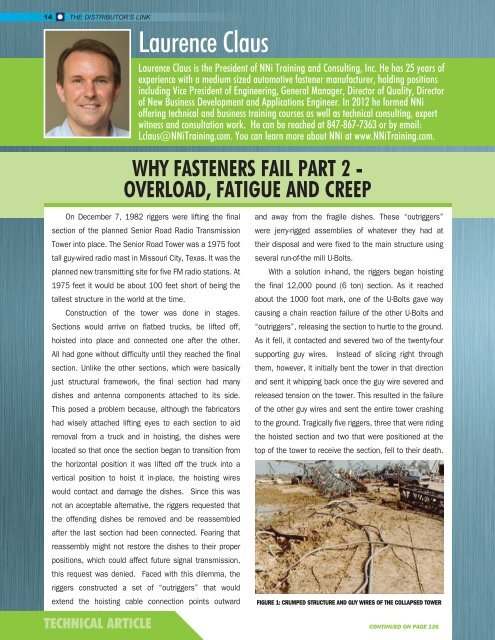FALL 2017
Distributor's Link Magazine Fall Issue 2017 / Vol 40 No4
Distributor's Link Magazine Fall Issue 2017 / Vol 40 No4
You also want an ePaper? Increase the reach of your titles
YUMPU automatically turns print PDFs into web optimized ePapers that Google loves.
14<br />
THE DISTRIBUTOR’S LINK<br />
Laurence Claus<br />
Laurence Claus is the President of NNi Training and Consulting, Inc. He has 25 years of<br />
experience with a medium sized automotive fastener manufacturer, holding positions<br />
including Vice President of Engineering, General Manager, Director of Quality, Director<br />
of New Business Development and Applications Engineer. In 2012 he formed NNi<br />
offering technical and business training courses as well as technical consulting, expert<br />
witness and consultation work. He can be reached at 847-867-7363 or by email:<br />
Lclaus@NNiTraining.com. You can learn more about NNi at www.NNiTraining.com.<br />
WHY FASTENERS FAIL PART 2 -<br />
OVERLOAD, FATIGUE AND CREEP<br />
On December 7, 1982 riggers were lifting the final<br />
section of the planned Senior Road Radio Transmission<br />
Tower into place. The Senior Road Tower was a 1975 foot<br />
tall guy-wired radio mast in Missouri City, Texas. It was the<br />
planned new transmitting site for five FM radio stations. At<br />
1975 feet it would be about 100 feet short of being the<br />
tallest structure in the world at the time.<br />
Construction of the tower was done in stages.<br />
Sections would arrive on flatbed trucks, be lifted off,<br />
hoisted into place and connected one after the other.<br />
All had gone without difficulty until they reached the final<br />
section. Unlike the other sections, which were basically<br />
just structural framework, the final section had many<br />
dishes and antenna components attached to its side.<br />
This posed a problem because, although the fabricators<br />
had wisely attached lifting eyes to each section to aid<br />
removal from a truck and in hoisting, the dishes were<br />
located so that once the section began to transition from<br />
the horizontal position it was lifted off the truck into a<br />
vertical position to hoist it in-place, the hoisting wires<br />
would contact and damage the dishes. Since this was<br />
not an acceptable alternative, the riggers requested that<br />
the offending dishes be removed and be reassembled<br />
after the last section had been connected. Fearing that<br />
reassembly might not restore the dishes to their proper<br />
positions, which could affect future signal transmission,<br />
this request was denied. Faced with this dilemma, the<br />
riggers constructed a set of “outriggers” that would<br />
extend the hoisting cable connection points outward<br />
TECHNICAL ARTICLE<br />
and away from the fragile dishes. These “outriggers”<br />
were jerry-rigged assemblies of whatever they had at<br />
their disposal and were fixed to the main structure using<br />
several run-of-the mill U-Bolts.<br />
With a solution in-hand, the riggers began hoisting<br />
the final 12,000 pound (6 ton) section. As it reached<br />
about the 1000 foot mark, one of the U-Bolts gave way<br />
causing a chain reaction failure of the other U-Bolts and<br />
“outriggers”, releasing the section to hurtle to the ground.<br />
As it fell, it contacted and severed two of the twenty-four<br />
supporting guy wires. Instead of slicing right through<br />
them, however, it initially bent the tower in that direction<br />
and sent it whipping back once the guy wire severed and<br />
released tension on the tower. This resulted in the failure<br />
of the other guy wires and sent the entire tower crashing<br />
to the ground. Tragically five riggers, three that were riding<br />
the hoisted section and two that were positioned at the<br />
top of the tower to receive the section, fell to their death.<br />
FIGURE 1: CRUMPED STRUCTURE AND GUY WIRES OF THE COLLAPSED TOWER<br />
CONTINUED ON PAGE 126

















